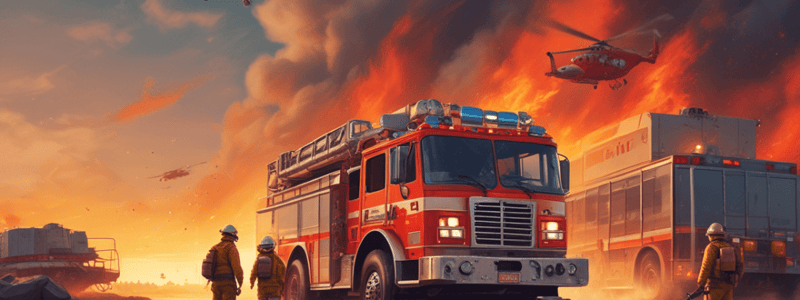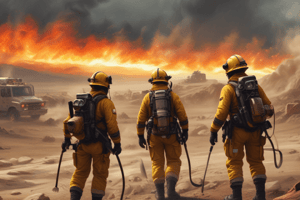Podcast
Questions and Answers
What is the advantage of having a pumper at the hydrant in a reverse lay operation?
What is the advantage of having a pumper at the hydrant in a reverse lay operation?
- It increases the risk of blocking the scene with LDH.
- It reduces the water flow capacity.
- It provides pump redundancy in case of mechanical issues. (correct)
- It delays the arrival of the first-due engine on scene.
Why may a reverse lay not be a viable option in certain situations?
Why may a reverse lay not be a viable option in certain situations?
- Because it is a newer tactic.
- Because of the limited water flow capacity.
- Due to the lack of personnel on scene.
- On dead-end streets, cul de sacs, and many apartment complexes. (correct)
What is the primary disadvantage of Plan C: Forward Lay by Second Engine?
What is the primary disadvantage of Plan C: Forward Lay by Second Engine?
- It requires two engines to lay a line.
- It delays the arrival of the first-due engine on scene.
- It requires an individual to charge the hydrant. (correct)
- It reduces the available water for initial operations.
What is the total available water for initial operations in Plan C?
What is the total available water for initial operations in Plan C?
What is the advantage of having more combat-ready personnel on scene in a reverse lay operation?
What is the advantage of having more combat-ready personnel on scene in a reverse lay operation?
What is the purpose of the second-due engine in Plan C?
What is the purpose of the second-due engine in Plan C?
Why is Plan D: Forward Lay by First-Due Engine a comfortable tactic for the District?
Why is Plan D: Forward Lay by First-Due Engine a comfortable tactic for the District?
What is the disadvantage of Plan D: Forward Lay by First-Due Engine?
What is the disadvantage of Plan D: Forward Lay by First-Due Engine?
What is the alternative to reverse lay if it is not easily implementable?
What is the alternative to reverse lay if it is not easily implementable?
What is the advantage of laying the supply line away from the scene in a reverse lay operation?
What is the advantage of laying the supply line away from the scene in a reverse lay operation?
Study Notes
Engineer's Role in Incident Mitigation
- Engineers must be able to think and act independently, even outside of their skillset, in situations such as operating an aerial in a high-rise rescue.
- Practicing all skillsets of the Engineer position is critical to successful incident mitigation.
Pump Chart Introduction
- The purpose of a pump chart is to provide pump operators with a shortcut to calculate the Total Pump Discharge Pressure (PDP).
- The pump chart provides values to get the pump operator within a range of an effective flow rate.
- Friction loss in a hose line varies based on factors such as manufacturing processes, materials, materials used, temperature, wear, and age.
Pump Chart Components
- The pump chart includes values for different nozzle sizes, flow rates, and friction loss.
- The chart is used to calculate the PDP using the formula: PDP = NP + FL + APPL + ELEV.
Pump Chart Examples
- Example 1: Calculating Friction Loss (FL) using the formula: FL = CQ2L.
- Example 2: Calculating PDP using the formula: PDP = NP + FL + APPL + ELEV.
- The St. John's Fire District Pump Chart is a tool that simplifies the calculation of PDP variables.
Standpipe and Supply Operations
- The standpipe and supply operation chart provides values for nozzle pressure, flow rate, and friction loss.
- The chart is used to calculate the PDP for standpipe operations.
Defensive Operations
- The deck gun and aerial water way operations have different PDP calculations.
- The deck gun operation uses a fixed PDP of 100 psi, while the aerial water way operation uses the formula: PDP = 100 psi + EVEL.
Water Supply
- The establishment of water supply is an integral component of effective mitigation.
- Engine companies should factor hydrant location into their apparatus placement.
- There are four plans for water supply operations: Plan A, Plan B (Reverse Lay), Plan C (Forward Lay with Booster Tank Backup), and Plan D (Forward Lay by First-Due Engine).
Plan B (Reverse Lay)
- The second-due engine lays away from the scene and establishes the water supply.
- The apparatus operator can pump the hydrant if a relay is required.
- The advantages of Reverse Lay include: more combat-ready personnel on scene, less likelihood of blocking the scene, enhanced flow capacity, and pump redundancy.
Plan C (Forward Lay with Booster Tank Backup)
- The second-due engine lays from the hydrant and proceeds to the scene, sharing its booster tank water with the first-due engine.
- This plan provides a total of 2,000 gallons of available water for initial operations.
- The primary disadvantage is that an individual from either the second-due engine or subsequent units must charge the hydrant.
Plan D (Forward Lay by First-Due Engine)
- This plan has been the typical water supply tactic utilized by the District.
- The primary disadvantage is that it delays the arrival of the first-due engine on scene to assess for life safety considerations.
Studying That Suits You
Use AI to generate personalized quizzes and flashcards to suit your learning preferences.
Related Documents
Description
This quiz assesses an engineer's ability to think and act independently in high-pressure situations. Scenarios include correcting errors with apparatus and conducting rescues in high-rise buildings.



